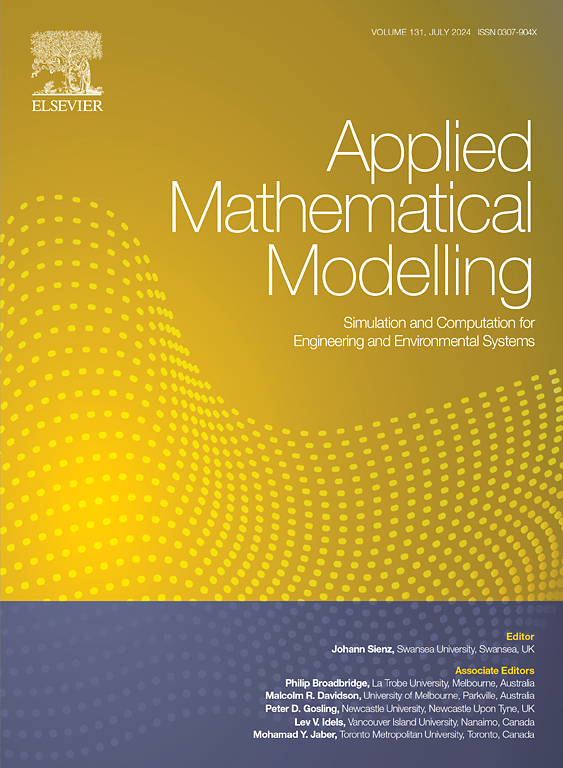Triggering probability of self-healing mechanisms in microencapsulated self-healing composites
IF 4.4
2区 工程技术
Q1 ENGINEERING, MULTIDISCIPLINARY
引用次数: 0
Abstract
Cracking is one of the critical causes of material failure, and early damage management by implanting microcapsules in the matrix is practical. Existing studies have focused on the improvement of self-healing systems and preparation technology of microcapsules’, but have paid less attention to the issue of the probability of triggering the self-healing mechanism in microencapsulated self-healing composites (MSC), which in turn is a critical factor in improving the self-healing capability of the MSC. To improve the design capability of the MSC, a mathematical model affecting the intersection of a random single crack with microcapsules in a chaotic state is constructed based on the geometric probability theory. Further, the effects of a single factor on the intersection probability of a crack with microcapsules are studied. The results show that (1) the intersection mathematical probability of a randomly expanding single crack with a microcapsule is simultaneously affected by material shape, crack width, microcapsule volume fraction, and microcapsule diameter. (2) To improve the self-healing ability of the MSC, pay more attention to the mathematical expectation value of the cracks intersecting the microcapsules. (3) Under the conditions of ensuring the mechanical properties of the MSC and microcapsules, increasing the volume fraction and diameter of microcapsules can improve the self-healing efficiency of the MSC.
微封装自愈复合材料自愈机制的触发概率
裂纹是材料失效的关键原因之一,通过在基体中植入微胶囊来进行早期损伤管理是切实可行的。现有研究主要集中在自愈合体系的改进和微胶囊的制备技术上,但对微胶囊自愈合复合材料(MSC)中自愈合机制的触发概率问题关注较少,而这又是提高 MSC 自愈合能力的关键因素。为了提高 MSC 的设计能力,我们基于几何概率论构建了一个影响随机单裂纹与处于混沌状态的微胶囊相交的数学模型。此外,还研究了单一因素对裂纹与微胶囊相交概率的影响。结果表明:(1)随机扩展的单条裂缝与微胶囊相交的数学概率同时受到材料形状、裂缝宽度、微胶囊体积分数和微胶囊直径的影响。(2)为提高 MSC 的自愈能力,应更加关注裂缝与微胶囊相交的数学期望值。(3)在保证 MSC 和微胶囊力学性能的条件下,增加微胶囊的体积分数和直径可以提高 MSC 的自愈合效率。
本文章由计算机程序翻译,如有差异,请以英文原文为准。
求助全文
约1分钟内获得全文
求助全文
来源期刊

Applied Mathematical Modelling
数学-工程:综合
CiteScore
9.80
自引率
8.00%
发文量
508
审稿时长
43 days
期刊介绍:
Applied Mathematical Modelling focuses on research related to the mathematical modelling of engineering and environmental processes, manufacturing, and industrial systems. A significant emerging area of research activity involves multiphysics processes, and contributions in this area are particularly encouraged.
This influential publication covers a wide spectrum of subjects including heat transfer, fluid mechanics, CFD, and transport phenomena; solid mechanics and mechanics of metals; electromagnets and MHD; reliability modelling and system optimization; finite volume, finite element, and boundary element procedures; modelling of inventory, industrial, manufacturing and logistics systems for viable decision making; civil engineering systems and structures; mineral and energy resources; relevant software engineering issues associated with CAD and CAE; and materials and metallurgical engineering.
Applied Mathematical Modelling is primarily interested in papers developing increased insights into real-world problems through novel mathematical modelling, novel applications or a combination of these. Papers employing existing numerical techniques must demonstrate sufficient novelty in the solution of practical problems. Papers on fuzzy logic in decision-making or purely financial mathematics are normally not considered. Research on fractional differential equations, bifurcation, and numerical methods needs to include practical examples. Population dynamics must solve realistic scenarios. Papers in the area of logistics and business modelling should demonstrate meaningful managerial insight. Submissions with no real-world application will not be considered.
 求助内容:
求助内容: 应助结果提醒方式:
应助结果提醒方式:


